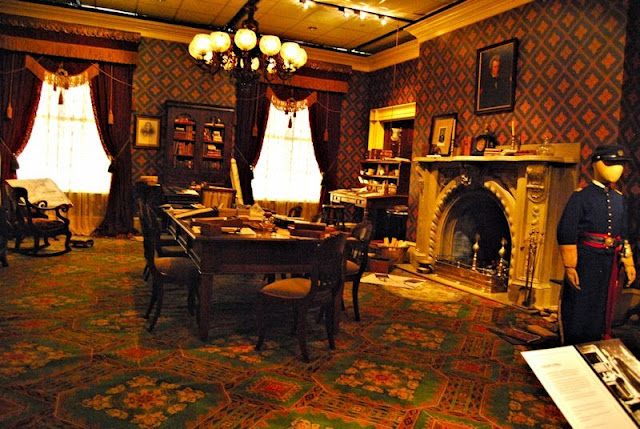The Ronald Reagan Presidential Library and Museum in Simi Valley has a most interesting exhibit
dedicated to not our 40th president (although he is also well
represented, starting with his name and statue at the front door), but our 16th
president, Abraham Lincoln. The
collection of signed documents, personal effects, books, papers, clothing, and
the bed and pillow where Lincoln rested after being shot, as well as set
decorations and costumes from the recent Steven Spielberg-directed DreamWorks
Studios’ film, Lincoln will be on
display until September 30th.
The most interesting
pieces, especially when contrasted with the way modern presidents operate, are
the speeches, letters, and documents in Lincoln’s own hand. Included here are a signed copy of both the
Emancipation Proclamation and the 13th Amendment. One document, a map of Huron drawn up by
Lincoln as a young man and surveyor, contains a spelling error. The map was sold to pay off creditors, but
the frontier town was never built. The
great man’s pocket watch is also on display, along with his iconographic stove
pipe hat.
Many of the pieces in
the exhibit are on loan to the library from across the nation. In addition to DreamWorks, the Library of Congress,
the Smithsonian Institution, National Museum of American History, the National
Archives, and the Abraham Lincoln Presidential Library and Museum in
Springfield, Illinois, are among the major lenders.
Of course, Ronald
Reagan is well documented and represented every day at the library that bears
his name. It is actually one of two
presidential libraries located near Los Angeles, the other being Richard Nixon’s
in Yorba Linda. Reagan’s life and
presidency are presented through photographs and artifacts, including a
searchable daily diary, his clothing and personal items, and lots and lots of
film clips, which is to be expected when the president is also a former
actor. Attention is given to nearly
every milestone in his presidency. There
are pieces of the Berlin Wall, and an informative installation on the fall of
communism and Reagan’s relationship with Soviet President Mikhail Gorbachev.
In speech writing and
personal correspondence, something Reagan was known for, many of the documents
were handwritten, at least in draft form.
And in this, he shares much with Lincoln. It was strange to see pictures and artifacts showing
Reagan writing by hand. These documents
were later typed up—on typewriters!—for publication. His speeches in type showed his additions and
notes, and were often in large typeface to enable him to read them at a podium. Throughout his presidency, Reagan kept a
daily diary in large red notebooks.
During the tour, people can peruse the pages of this diary by entering
specific dates, or by flipping through pages in sequence. The complete, unabridged diary is available
in a two-volume set in the museum store for $150.
What gets the most
press in the entire library is the installation of Air Force One. I remember when it was moved through the Los
Angeles area from 11 PM to 5 AM on June 20-21, 2003. According to the museum, the Boeing 707
traveled “on a specially designed trailer crossing four freeways, traveling 104
miles.” The aircraft flew seven U.S.
presidents—Nixon, Ford, Carter, Reagan, H.W. Bush, Clinton, and W. Bush. Surrounding the mammoth plane are Marine One,
a presidential limousine, a Secret Service SUV, and a police car with several
motorcycles. Patrons get to file through
the plane and see how the president traveled.
I found the inside quite small, actually, and a little
claustrophobic. I’m sure the plane President
Obama uses, a Boeing 747-200B, is roomier.
I think the least
impressive thing about my day at the library were the other patrons in
attendance. Walking through the exhibits
and galleries, I was struck by the amount of misinformation people were
sharing. Doesn’t anyone teach American
history anymore? It was rather
disconcerting to overhear some of the “facts” that were being shared. Most people acted as if they were at an
amusement park, not a library or museum.
I do think when looking at an artifact of historical significance,
especially one from a murder of a president like the bloody pillow from under
Lincoln’s head, more respect should be paid.
Instead, the mother and son next to me were arguing: “I don’t see the blood,” the teenage son kept insisting. “It’s right there,” his mother responded
while putting fingertip to glass.
Admission to the museum
is $16 for adults, $9 for teenagers, and children can get in for $5. Four and under are free. The museum is open 10 AM to 5 PM every day. Parking is free, but the lot fills up
fast. I had to park down the hill from
the library on the street. Trams are
provided for offsite parking which drop patrons right at the front door of the
library, and returns them to their cars when their visit is over. The library and museum tour involves a lot of
walking, approximately two miles, according to one docent I spoke with. There are ample break areas, including two
restaurants where one could take a break, sit down, and have a cup of coffee or
other beverage as well as food.
Photography without flash is allowed in the museum, but no pictures may
be taken inside of Air Force One.











2 comments:
This is gorgeous!
Thank you!
Post a Comment